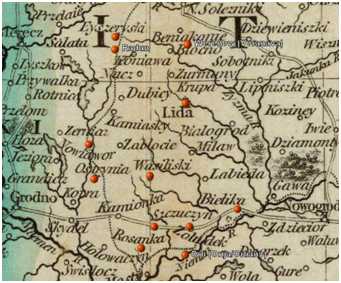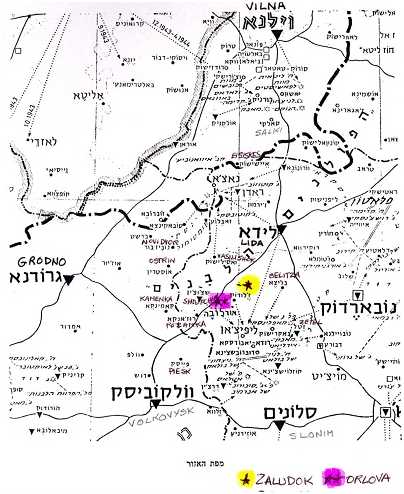 |
|
| Contents | |
| Lida Uezd Homepage | |
| Lida Uezd History | |
| Lida Uezd Towns | |
| Lida
Uezd Maps |
|
| Searchable
Databases |
|
| Lida
Uezd
during the Holocaust |
|
| JewishGen
Home Page |
|
| KehilaLinks
Home Page |
|
|
|
Alternate
names:
Vasiliški, Vasilishki and
Василишки [Rus], Vasilishok and
Yiddish: וואסילישוק / וואַסילישאָ [Yid], Wasiliszki
[Pol], Vasiliški and
Васілішкі [Bel], Vosyliškės [Lith],
Vasilishak, Vasilishuk at 53°47'
N, 24°51' E, 20 miles WSW of Lida, 42 miles
E of Grodno. and the dependent
villages of Aleksandrowka, Arcisze, Bakszty,
Baniuki, Bojary, Chodele, Doliniany, Drobysze, Dworczany, Dziechciary,
Glinicze, Gromki at 5350 2440, Gudziszki, Hlinkowszczna, Holoszewicze,
Hubicze, Jukiewicze, Kaszniaki, Konstrantynowka, Kopciuba, Korewicze,
Koscieniewo, Koszczyce, Kozly Male, Kozly Wielkie, Krasna, Kronki,
Lachowka, Lazowce, Leluszowce, Lodyga, Markowce, Mosiowce, Niewisza,
Oleszkowce, Plebanowce, Prymaki, Rogieloce, Rozniatycze, Rusaczki,
Rusanowce, Starodworce, Swirydy, Szermicze, Szkierty, Szkordzie,
Szlachtowszczyzna, Wojejkowce, Wojszczuki, Zbroszki, Zieniewicze,
Zybaly and the estates,
colonies, and hamlets of Anielkowo,
Bogudzieki, Boleslowo, Borowszczyzna, Buciorowszczyzna, Chmielisko,
Cydzikowszczyzna, Dramowicze, Feliksowo, Gaj, Gornofel, Grabniki,
Hlebowce, Hlinkowszczyzna, Howlowiczpol and I and II, Janowszczyzna,
Jakubowo, Jozefowo, Juljanowo, Justynowo, Kandybowo, Karolin, Kopciuha,
Koszczyce, Kozuliszki, Krupowszczyzna, Kurhany, Lachowka, Lebiodka I,
II, III, IV, V, and VI, Lucjanowo, Marysinek, Miekisze, Niewisza,
Niewisza Mala, Nowinka, Olenszczyzna, Ostrowo, Paulinowo, Piasczyzna,
Podbrezezne, Podswietne, Popielszki, Raczkowszczyzna, Rohaczowszczyzna,
Rozniatycze, Rudowo, Rybaki, Sandokowszczyzna, Sasowszczyzna, Slobodka,
Sosna, Stajniszki, Stanislawowo, Stankiszki-Misiurowm, Stare Dwory,
Starodworce, Szejbakpol, Szlachtowszczyzna, Szostakowce, Teresino,
Ustron, Wasiliszki Stare, Widowka, Wielka Weis, Wierzch-Lebiodka,
Wojkowszczyzna, Wojnilowce, Wolczynki, Wolodkowszczyzna, Zagorze,
Zacisze 1992 population: 2,678
people with 1,184 buildings. Vasilishki, now, is a village in Scucyn
district, Grodno oblast situated on the river Lebeda, thirty-two
kilometers s from Scucyn, seventeen kilometers s from the railway
station at Skribavtsy. The town of Vasilishki is
connected to the historic events in the relationship between Poland and
Lithuania. Near it is the village of Shaibakapolia
("Shaibak Field"), where the Lithuanian Prince Radziwil, in 1242,
defeated the Tartar General Shaibak, who was head of Khan Batai's
armies. Khan Batai was Ghengis Khan's grandson. Radziwil's victory
saved the whole of Europe from a renewed invasion of the Tartars, who
threatened to destroy all the settlements in their way. Vasilishki was first
mentioned in the historical Chronicles of the first half of the
fifteenth century. King Casimir built the Cathedral in Vasilishki in
1489. After the Cathedral gradually deteriorated, it was renovated in
1747. Vasilishki had, by this time, become "Starostvo" (capital city)
of the region, which included more than 20 rural settlements. Among its
rulers, called "Starosto", were: 1499 - Jan Statkovich; 1501 - Vasil
Lavovitch Helinski; 1505 - Stanislav Kishka; 1507 - Jan Tchitovich;
1518 - Yakov Kontzivich; 1523 - Jan Radziwil; 1546 - Caspar Kantsivich;
1547 - Prince Nikolay Radziwil; 1569 - Jan Volkovich. In 1658, a judge from
Lida, Martin Limont, built a synagogue there. In 1769, another Catholic
Church was built. In 1659, a meeting of the governors of Lida povet was
held there. In 1706, the Polish King Stanislas Leszczinski camped here
and received the surrender of the Lithuanian nobles who had fought on
the side of Karl XII, King of Sweden. In 1766, the "Starost" of
Vasilishki was the well-known Vilna Viavoda, Mihail Aginski
(Michael-Casimir Oginski. The last "Starosta" was the "Podkomorni"
Alexandrovich, to whom ownership of the town passed. With the
annexation of the region to Russia, after the Partition of Poland, the
"Starotsvo" in Vasilishki was canceled. In 1795, Vasilishki was
in Russian Empire as the volost center of Lida povet. The 1858
correspondent to Hamagid for Vasilishki was Shmuel Yanus, living in
Druzgenik. In 1866, mestechko Vasilishki had 244 houses and 1841
people, an Orthodox Church, a Catholic church, one synagogue, a public
school, a post office, and a weekly market. Wasiliszki remained in
Grodnenskaya Gubernya (Grodno Gubernya) under Russian rule, with a 1905
population of 1,983. In 1887, Vasilkov in
Grodno province of the Russian Empire had three wood church and
monastery properties, 1 wood social building, one stone dwelling, 419
wood dwellings, and eight wood stores. According to the 1897 Census of
Vasilishki, there were 2780 inhabitants (2,081 of them were Jewish.) In 1907, the rabbi was
Yosef David Rubenshtein (1847-?). He had been rabbi in Horodishtch,
Minsk. In 1909, Vasilishki opened a male Jewish school. During the
First World War, beginning in 1915, Vasilishki was occupied by German
troops. By 1921, political control belonged to Poland. In 1928,
Wasiliszki was designated as a miasteczko (small town) and gmina
wiejska (parish village), council office for the surrounding villages.
The Justice of the Peace was in Wasilizki and the Justice Court in
Wilno. The 1928 miasteczko population was 1,874. The railway was
fifteen kilometers away in Skrzbowce.The post office, telephone, and
telegraph were in Wasiliszki. Wasiliszki had one Catholic church, a
"House of People, a volunteer fire department, a Merchants Association,
tanneries and mills. Markets were on Tuesdays for horses, cattle, and
pigs. In 1928, imenie "Stanislavovo" (gmina Vasilishki, Lidski povet)
belonged to Mikhail Belinski. n 1919-1939, Wasiliszki
was part of Grodno powiat, Białystok Voivodeship, Poland. Beginning in
1939, the town belonged to the Belorussian Soviet Socialist Republic.
From June 1941 until July 1944, Nazis occupied Vasilishki. The German
organized ghetto ended on the 10-11th of May 1942 when the Nazis
destroyed it. 2,159 Jews were killed. Until August 3, 1954,
Vasilishki's designation was a small town (mestechko). After January
20, 1960, Vasiliski was in Radun district. Since January 25,1962,
Vasiliski has been in Scucyn district. The 1970 population was 909 with
three hundred houses, a secondary school, a House of Culture, a post
office, and a Monument to the Victims of Nazis (W. W. II Memorial). One
architectural historical site is preserved: The Catholic Church of Yan
Hristitelj. Mihail Kleafas Aginski
(or Oginski Russian spelling) was born October 7,1765 and died October
15,1833. He was the son of Andrew Aginski and received a very good
education. He was a delegate to Soim in 1786, a member of the Treasury
Committee of the Great Lithuanian Principality, Honorable Person of
Lithuania (1789), the Ambassador in Holland (1789) and was engaged in
diplomatic work in London. In 1791, he swore an oath to Ekaterina II
(Russian Empress) that enabled him to preserve all his estates on the
territory of Western Belarus. He supported the Constitution of May
3,1791. After the victory of the Targovitskaya Confederation, he
immigrated to Germany and all his estates were confiscated. On his
return to his Motherland, his property was returned to him under on
condition that he will join the Targovitskaya Confederation. For four
years, he was a delegate to the Soim of 1788-1792 and the Grodno Soim
in 1793. During the Uprising of 1794, he joined the side of Vilna and
became a member of the Highest Lithuanian Rada (government). He formed
and financed a battalion of riflemen and was its commander in several
fights. In 1794, twice together with his battalion and with two hundred
housed fighters, he tried to break through to Mensk Gubernya in order
to organize an uprising there. In 1794, he broke through to Dinaburg
(now Daygapils). When the uprising was suppressed, he went to Austria.
He lived in Vienna, in Venice, and in Paris. In 1802, he returned to
his Motherland where all his estates were returned to him. He lived in
the estate Zalesse near Smorgon. In 1810, he became a senator and was
awarded an Order of Vladimir and Alexander Hevski. He met Russian Tsar
Alexander I in St. Petersburg, in Vilno, in Mogilev, and in Vitebsk. He
was the author of Plan of Oginski (The Plan of Restoration of
Lithuanian Principality) which he handed over to Russian Tsar himself
in 1811. In 1823, together with his family he went to Italy where he
died. He is well known as a composer of many musical pieces for the
piano. In Paris, he published 4 volumes: "Memories
About Poland and Polish people from 1788 to 1815" (in French,
but in 1870-1873, the books were translated into Polish). He wrote and
published also "The Lists About Music"
in 1828. SOURCES:
If
you have Lida uezd
materials to share, please considering donating it.
If you read Yiddish or Hebrew, please contact us.
Records are
held both in Grodno and Vilna archives.For Lida records translation,
your tax deductible contribution by credit card via the secure server
at either group or by mail will grow our knowledge. For a $100
donation, you receive all these records translated two years ahead of
their posting on JewishGen. Every penny collected is used for Lida uezd
projects only. Records include censuses; family lists; marriages,
births, death records; prenumeraten lists; and more. Please contact Judy Baston
with any questions.For current translations, please see the ALD:
All Lithuanian Database and Belarus
SIG Database.
|

